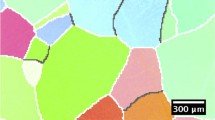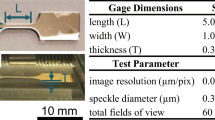Abstract
A combined approach of scanning electron microscopy and digital image correlation was used to examine microstructure-scale strain localization and active deformation mechanisms in ultrafine-grained (UFG) high purity (99.99%) aluminum processed by equal-channel angular pressing (ECAP). The results from tensile tests demonstrate a strong relationship between the heterogeneous microstructure and strain localization. The localized deformation was investigated in areas that contain significantly different microstructural features typical of ECAP processed aluminum. It was found that areas of the UFG microstructure containing primarily low angle grain boundaries deformed by dislocation slip and behaved similarly to a coarse-grained material. The greatest strain localization occurred at high angle grain boundaries (HAGBs) separating distinct microstructure regions and with median surface trace angles of approximately 26.6°. In areas of banded microstructure, shear strain localization as high as 30% and shear displacements of up to 500 nm occurred at the HAGBs separating bands, suggesting grain boundary sliding.











Similar content being viewed by others
References
R.Z. Valiev, Y. Estrin, Z. Horita, T.G. Langdon, M.J. Zechetbauer, and Y.T. Zhu: Producing bulk ultrafine-grained materials by severe plastic deformation. JOM 58(4), 33 (2006).
R.Z. Valiev, N.A. Enikeev, M.Y. Murashkin, V.U. Kazykhanov, and X. Sauvage: On the origin of the extremely high strength of ultrafine-grained Al alloys produced by severe plastic deformation. Scr. Mater. 63, 949 (2010).
R.Z. Valiev and T.G. Langdon: Principles of equal-channel angular pressing as a processing tool for grain refinement. Prog. Mater. Sci. 51, 881 (2006).
R.Z. Valiev, I.V. Alexandrov, Y.T. Zhu, and T.C. Lowe: Paradox of strength and ductility in metals processed by severe plastic deformation. J. Mater. Res. 17, 5 (2002).
J. Dvorak, V. Sklenicka, and Z. Horita: Microstructural evolution and mechanical properties of high purity aluminium processed by equal-channel angular pressing. Mater. Trans. 49, 15 (2008).
Y. Estrin and A. Vinogradov: Extreme grain refinement by severe plastic deformation: A wealth of challenging science. Acta Mater. 61, 782 (2013).
T.C. Lowe: Metals and alloys nanostructured by severe plastic deformation: Commercialization pathways. JOM 58(4), 28 (2006).
R.Z. Valiev, I.P. Semenova, V.V. Latysh, H. Rack, T.C. Lowe, J. Petruzelka, L. Dluhos, D. Hrusak, and J. Sochova: Nanostructured titanium for biomedical applications. Adv. Biomater. 10, B15 (2008).
Y. Iwahashi, J. Wang, Z. Horita, M. Nemoto, and T.G. Langdon: Principle of equal-channel angular pressing for the processing of ultra-fine grained materials. Scr. Mater. 35, 143 (1996).
T.G. Langdon: The principles of grain refinement in equal-channel angular pressing. Mater. Sci. Eng., A 462, 3 (2007).
T.G. Langdon: Twenty-five years of ultrafine-grained materials: Achieving exceptional properties through grain refinement. Acta Mater. 61, 7035 (2013).
M. Furukawa, Z. Horita, and T.G. Langdon: Factors influencing the shearing patterns in equal-channel angular pressing. Mater. Sci. Eng., A 332, 97 (2002).
Y. Iwahashi, M. Furukawa, Z. Horita, M. Nemoto, and T.G. Langdon: Microstructural characteristics of ultrafine-grained aluminum produced using equal-channel angular pressing. Metall. Mater. Trans. A 29, 2245 (1998).
I.J. Beyerlein and L.S. Tóth: Texture evolution in equal-channel angular extrusion. Prog. Mater. Sci. 54, 427 (2009).
S.D. Terhune, D.L. Swisher, K. Oh-ishi, Z. Horita, T.G. Langdon, and T.R. McNelley: An investigation of microstructure and grain-boundary evolution during ECA pressing of pure aluminum. Metall. Mater. Trans. A 33, 2173 (2002).
K. Oh-ishi, A.P. Zhilyaev, and T.R. McNelley: Effect of strain path on evolution of deformation bands during ECAP of pure aluminum. Mater. Sci. Eng., A 410–411, 183 (2005).
A.P. Zhilyaev, D.L. Swisher, K. Oh-ishi, T.G. Langdon, and T.R. McNelley: Microtexture and microstructure evolution during processing of pure aluminum by repetitive ECAP. Mater. Sci. Eng., A 429, 137 (2006).
M. Reihanian, R. Ebrahimi, M.M. Moshksar, D. Terada, and N. Tsuji: Microstructure quantification and correlation with flow stress of ultrafine grained commercially pure Al fabricated by equal channel angular pressing (ECAP). Mater. Charact. 59, 1312 (2008).
S. Li, I.J. Beyerlein, D.J. Alexander, and S.C. Vogel: Texture evolution during equal channel angular extrusion: Effect of initial texture from experiment and simulation. Scr. Mater. 52, 1099 (2005).
Y.T. Zhu and T.C. Lowe: Observations and issues on mechanisms of grain refinement during ECAP process. Mater. Sci. Eng., A 291, 46 (2000).
M. Kawasaki, Z. Horita, and T.G. Langdon: Microstructural evolution in high purity aluminum processed by ECAP. Mater. Sci. Eng., A 524, 143 (2009).
N.Q. Chinh, P. Szommer, Z. Horita, and T.G. Langdon: Experimental evidence for grain-boundary sliding in ultrafine-grained aluminum processed by severe plastic deformation. Adv. Mater. 18, 34 (2006).
N.Q. Chinh, P. Szommer, T. Csanádi, and T.G. Langdon: Flow processes at low temperatures in ultrafine-grained aluminum. Mater. Sci. Eng., A 434, 326 (2006).
N.Q. Chinh, T. Győri, R.Z. Valiev, P. Szommer, G. Varga, K. Havancsák, and T.G. Langdon: Observations of unique plastic behavior in micro-pillars of an ultrafine-grained alloy. MRS Commun. 2, 75 (2012).
I. Sabirov, M.R. Barnett, Y. Estrin, I. Timokhina, and P.D. Hodgson: Deformation mechanisms in an ultra-fine grained Al alloy. Int. J. Mater. Res. 100, 1679 (2009).
I. Sabirov, M.R. Barnett, Y. Estrin, and P.D. Hodgson: The effect of strain rate on the deformation mechanisms and the strain rate sensitivity of an ultra-fine-grained Al alloy. Scr. Mater. 61, 181 (2009).
I. Sabirov, Y. Estrin, M.R. Barnett, I. Timokhina, and P.D. Hodgson: Tensile deformation of an ultrafine-grained aluminium alloy: Micro shear banding and grain boundary sliding. Acta Mater. 56, 2223 (2008).
K.V. Ivanov and E.V. Naydenkin: Grain boundary sliding in ultrafine-grained aluminum under tension at room temperature. Scr. Mater. 66, 511 (2012).
J. May, H.W. Höppel, and M. Göken: Strain rate sensitivity of ultrafine-grained aluminium processed by severe plastic deformation. Scr. Mater. 53, 189 (2005).
H.W. Höppel, J. May, P. Eisenlohr, and M. Göken: Strain rate sensitivity of ultrafine-grained materials. Z. Metallkd. 96, 566 (2005).
A. Böhner, V. Maier, K. Durst, H.W. Höppel, and M. Göken: Macro- and nanomechanical properties and strain rate sensitivity of accumulative roll bonded and equal channel angular pressed ultrafine-grained materials. Adv. Eng. Mater. 13, 251 (2011).
W.H. Peters and W.F. Ranson: Digital imaging techniques in experimental stress analysis. Opt. Eng. 21, 427 (1982).
M.A. Sutton, W.J. Wolters, W.H. Peters, W.F. Ranson, and S.R. McNeill: Determination of displacements using an improved digital correlation method. Image Vision Comput. 1, 133 (1983).
M.A. Sutton, J-J. Orteu, and H. Schreier: Digital Image Correlation (DIC), in Image Correlation for Shape, Motion and Deformation Measurements (Springer US, Boston, MA, 2009), pp. 81–116.
B. Ahn, E.J. Lavernia, and S.R. Nutt: Dynamic observations of deformation in an ultrafine-grained Al–Mg alloy with bimodal grain structure. J. Mater. Sci. 43, 7403 (2008).
B. Ahn and S.R. Nutt: Strain mapping of Al–Mg Alloy with multi-scale grain structure using digital image correlation method. Exp. Mech. 50, 117 (2010).
Y. Zhang, T.D. Topping, E.J. Lavernia, and S.R. Nutt: Dynamic micro-strain analysis of ultrafine-grained aluminum magnesium alloy using digital image correlation. Metall. Mater. Trans. A 45, 47 (2013).
K. Nakashima, Z. Horita, M. Nemoto, and T.G. Langdon: Development of a multi-pass facility for equal-channel angular pressing to high total strains. Mater. Sci. Eng., A 281, 82 (2000).
M. Furukawa, Y. Iwahashi, Z. Horita, M. Nemoto, and T.G. Langdon: The shearing characteristics associated with equal-channel angular pressing. Mater. Sci. Eng., A 257, 328 (1998).
K. Oh-ishi, Z. Horita, M. Furukawa, M. Nemoto, and T.G. Langdon: Optimizing the rotation conditions for grain refinement in equal-channel angular pressing. Metall. Mater. Trans. A 29, 2011 (1998).
A.D. Kammers and S. Daly: Self-assembled nanoparticle surface patterning for improved digital image correlation in a scanning electron microscope. Exp. Mech. 53, 1333 (2013).
Vic-2D [software]: Correlated Solutions Inc, Columbia, SC, 2009.
A.D. Kammers and S. Daly: Digital image correlation under scanning electron microscopy: Methodology and validation. Exp. Mech. 53, 1743 (2013).
M.A. Sutton, N. Li, D.C. Joy, A.P. Reynolds, and X. Li: Scanning electron microscopy for quantitative small and large deformation measurements Part I: SEM imaging at magnifications from 200 to 10,000. Exp. Mech. 47, 775 (2007).
M.A. Sutton, N. Li, D. Garcia, N. Cornille, J-J. Orteu, S.R. McNeill, H.W. Schreier, X. Li, and A.P. Reynolds: Scanning electron microscopy for quantitative small and large deformation measurements Part II: Experimental validation for magnifications from 200 to 10,000. Exp. Mech. 47, 789 (2007).
M.A. Sutton, N. Li, D. Garcia, N. Cornille, J-J. Orteu, S.R. McNeill, H.W. Schreier, and X. Li: Metrology in a scanning electron microscope: Theoretical developments and experimental validation. Meas. Sci. Technol. 17, 2613 (2006).
M. Bornert, F. Brémand, P. Doumalin, J-C. Dupré, M. Fazzini, M. Grédiac, F. Hild, S. Mistou, J. Molimard, J-J. Orteu, L. Robert, Y. Surrel, P. Vacher, and B. Wattrisse: Assessment of digital image correlation measurement errors: Methodology and results. Exp. Mech. 49, 353 (2009).
J. Luster and M.A. Morris: Compatibility of deformation in two-phase Ti-Al alloys: Dependence on microstructure and orientation relationships. Metall. Mater. Trans. A 26, 1745 (1995).
T.R. Bieler, P. Eisenlohr, F. Roters, D. Kumar, D.E. Mason, M.A. Crimp, and D. Raabe: The role of heterogeneous deformation on damage nucleation at grain boundaries in single phase metals. Int. J. Plast. 25, 1655 (2009).
ACKNOWLEDGMENTS
This work was supported by the National Science Foundation under Grant No. 092753 and by the Rackham Graduate School Non-Traditional Student Fellowship from the University of Michigan. The authors would like to acknowledge Sara Nitz for her sample preparation work and experimental assistance. Portions of this work were performed at the Electron Microbeam Analysis Laboratory (EMAL) at the University of Michigan and at the Lurie Nanofabrication Facility (LNF), a member of the National Nanotechnology Infrastructure Network, which is supported in part by the National Science Foundation. The work was also supported in part by the National Science Foundation under Grant No. DMR-1160966 (JW-N and TGL) and in part by the European Research Council under ERC Grant Agreement No. 267464-SPDMETALS (TGL).
Author information
Authors and Affiliations
Corresponding author
Rights and permissions
About this article
Cite this article
Kammers, A.D., Wongsa-Ngam, J., Langdon, T.G. et al. The effect of microstructure heterogeneity on the microscale deformation of ultrafine-grained aluminum. Journal of Materials Research 29, 1664–1674 (2014). https://doi.org/10.1557/jmr.2014.207
Received:
Accepted:
Published:
Issue Date:
DOI: https://doi.org/10.1557/jmr.2014.207




